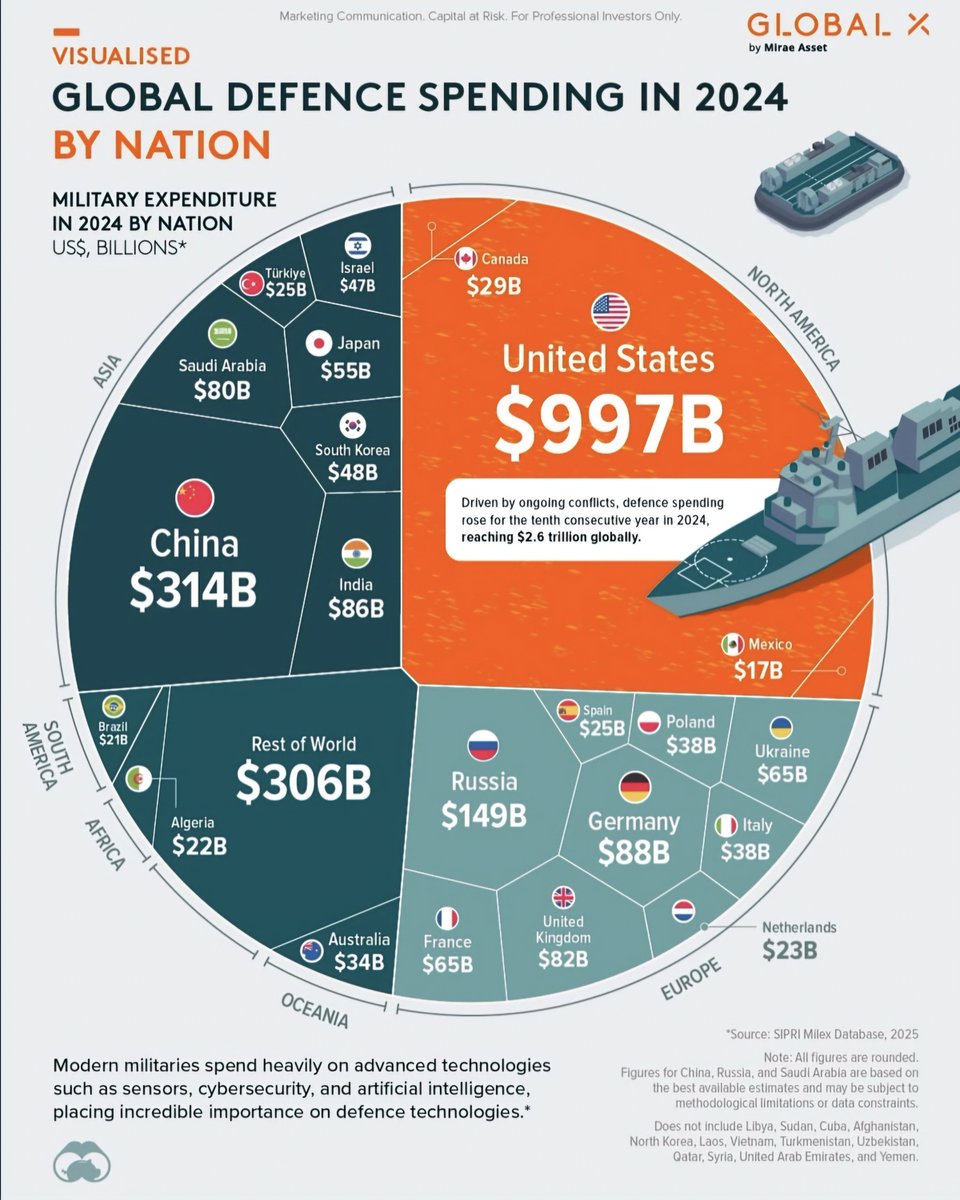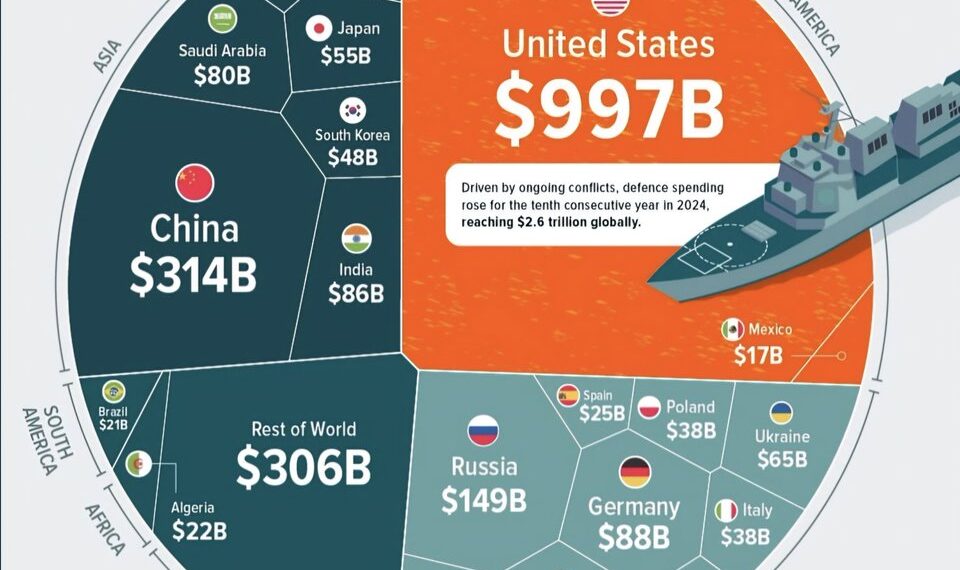Select Language:
Global Defense Spending Projections for 2024: A Comprehensive Overview
As nations around the globe prioritize their defense budgets, the data for 2024 reveals significant trends in military spending. The SIPRI Milex Database offers insight into which countries are spending the most on their defense, reflecting geopolitical tensions and strategic priorities. Below is a detailed breakdown highlighting the top spenders in global defense for 2024.
United States – $997 Billion
Leading the pack, the United States allocates a staggering $997 billion to its defense budget. This commitment reflects the country’s strategic priorities in maintaining global military dominance and protecting national interests. With ongoing investments in cutting-edge technology and military readiness, the U.S. continues to outpace all other nations in defense spending.
China – $314 Billion
China follows in a distant second with a projected defense budget of $314 billion. The Chinese government is rapidly expanding its military capabilities, emphasizing modernization and advanced technology. Ongoing tensions in the South China Sea and concerns over Taiwan have driven significant increases in military expenditure.
Russia – $149 Billion
Amidst geopolitical tensions, Russia has earmarked $149 billion for its defense. This substantial budget supports the nation’s military operations in Ukraine and the strengthening of its armed forces. As global conflicts evolve, Russia’s commitment to defense spending reflects its desire to be perceived as a major military power.
Germany – $88 Billion
Germany’s defense budget is set at $88 billion, reflecting a shift in policy as the country responds to rising threats in Europe. With an increased focus on NATO obligations and general security throughout the continent, this budget signifies a new era for German military investments.
India – $86 Billion
India’s projected defense spending of $86 billion indicates its commitment to self-reliance in defense capabilities, especially amid ongoing tensions with neighboring nations. This budget aims to bolster its military features by enhancing infrastructure and modernizing its armed forces.
United Kingdom – $82 Billion
With a budget of $82 billion, the United Kingdom is heavily investing in defense technologies and capabilities. The UK is also focusing on strategic alliances and commitments through NATO, reinforcing its military capacity in a changing global landscape.
Saudi Arabia – $80 Billion
Saudi Arabia’s defense expenditure is reported at $80 billion, aimed at strengthening regional security amidst conflicts in the Middle East. The kingdom is focused on advanced defense technologies, including aerial and missile defense systems, as part of its Vision 2030 plan.
Ukraine – $65 Billion
In light of ongoing conflicts, Ukraine’s defense budget stands at $65 billion. This significant allocation shows the nation’s dedication to bolstering its military capabilities against external aggression, particularly from Russia.
France – $65 Billion
France maintains a stable defense budget pegged at $65 billion, prioritizing the modernization of its forces and its commitment to NATO. The focus is primarily on enhancing capabilities in cybersecurity and innovative military technologies.
Japan – $55 Billion
With a defense budget of $55 billion, Japan continues to focus on security in the Asia-Pacific region. The nation is also moving towards enhancing its military capacity amid rising Chinese influence.
South Korea – $48 Billion
South Korea’s defense expenditure, estimated at $48 billion, reflects its commitment to countering threats from North Korea. The country is also investing in advanced defense technologies to maintain its deterrence capabilities.
Israel – $47 Billion
Israel’s projected defense budget of $47 billion underscores its emphasis on maintaining military superiority in a challenging region. The country is committed to investing in missile defense systems and cybersecurity.
Italy – $38 Billion
Italy allocates approximately $38 billion for defense, focusing on international missions and improving its military capabilities across the board.
Poland – $38 Billion
Poland’s defense budget is also set at $38 billion. Growing concerns over security in Eastern Europe have prompted the country to increase its military spending significantly in recent years.
Australia – $34 Billion
Australia’s defense budget of $34 billion reflects its commitment to regional security and strengthening alliances, particularly with the U.S. and other democratic nations.
Canada – $29 Billion
With a defense expenditure of $29 billion, Canada is concentrating on modernizing its military and fulfilling NATO commitments.
Spain – $25 Billion
Spain’s defense budget is slated at $25 billion, focusing on enhancing operational capabilities and international collaborations.
Turkey – $25 Billion
Turkey matches Spain with $25 billion dedicated to its defense, reflecting continuous military investments amid regional tensions.
Netherlands – $23 Billion
The Netherlands has a defense budget of $23 billion aimed at modernizing its military and enhancing cooperation within NATO structures.
Algeria – $22 Billion
Algeria’s defense spending is at $22 billion as the country seeks to secure its borders and maintain national sovereignty.
Brazil – $21 Billion
Brazil allocates $21 billion for defense, focusing on internal security and capacity-building for its armed forces.
Mexico – $17 Billion
Lastly, Mexico’s projected defense spending stands at $17 billion, which is dedicated primarily to internal security challenges and drug-related violence.
Conclusion
The data paints a vivid picture of global military spending as nations respond to evolving threats and shifts in geopolitical dynamics. As countries prioritize their defense strategies, investments in advanced technology such as sensors, cybersecurity, and artificial intelligence become increasingly essential. While figures are subject to change, the commitment to military spending is a clear indicator of the priorities that define modern national security.

Note: The figures for China, Russia, and Saudi Arabia are based on available estimates and may be subject to methodological limitations. Some countries are not included in this analysis due to missing data.






